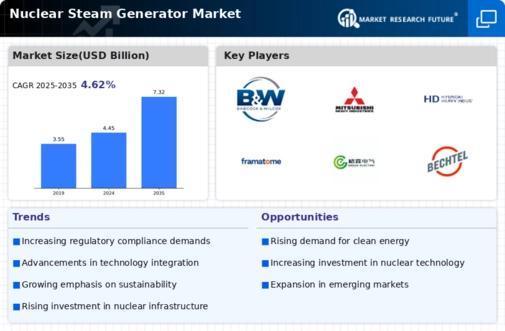Growing Energy Demand
The Global Nuclear Steam Generator Market Industry is experiencing a surge in demand for energy, driven by increasing global population and industrialization. As countries strive to meet energy needs sustainably, nuclear power emerges as a viable solution. In 2024, the market is valued at approximately 4.45 USD Billion, reflecting a growing reliance on nuclear energy. This trend is expected to continue, with projections indicating a market value of 7.32 USD Billion by 2035. The anticipated compound annual growth rate of 4.63% from 2025 to 2035 underscores the industry's potential to address energy shortages while minimizing carbon emissions.
Focus on Carbon Neutrality
As nations commit to achieving carbon neutrality, the Global Nuclear Steam Generator Market Industry is positioned to play a crucial role in this transition. Nuclear power is recognized for its low greenhouse gas emissions, making it an attractive alternative to fossil fuels. Countries are increasingly investing in nuclear technology to reduce their carbon footprints while ensuring a stable energy supply. The emphasis on clean energy sources is likely to drive demand for nuclear steam generators, as they are integral to the operation of nuclear power plants. This shift towards sustainability is expected to significantly impact market dynamics in the coming decade.
Technological Advancements
Technological innovations play a pivotal role in the Global Nuclear Steam Generator Market Industry, enhancing efficiency and safety in nuclear power generation. Advances in materials science and engineering have led to the development of more resilient steam generators, which can withstand higher pressures and temperatures. These improvements not only extend the lifespan of existing facilities but also reduce operational costs. Furthermore, the integration of digital technologies and automation in monitoring systems enhances operational reliability. As these technologies evolve, they are likely to attract investments, thereby propelling market growth and ensuring that nuclear energy remains a competitive option in the global energy landscape.
Market Trends and Projections
The Global Nuclear Steam Generator Market Industry is poised for growth, with projections indicating a market value of 7.32 USD Billion by 2035. The anticipated compound annual growth rate of 4.63% from 2025 to 2035 suggests a robust expansion trajectory. Key trends influencing this growth include the increasing adoption of advanced nuclear technologies, heightened focus on sustainability, and supportive regulatory frameworks. As countries worldwide prioritize energy diversification and carbon reduction, the nuclear steam generator market is likely to benefit from increased investments and innovations, positioning it as a vital component of the global energy landscape.
Global Energy Security Concerns
The Global Nuclear Steam Generator Market Industry is influenced by rising concerns over energy security and geopolitical tensions. As nations seek to diversify their energy sources and reduce dependence on fossil fuels, nuclear energy emerges as a strategic option. The stability and reliability of nuclear power can mitigate the risks associated with fluctuating oil and gas prices. Furthermore, countries are increasingly investing in nuclear technology to enhance their energy independence. This focus on energy security is likely to drive growth in the nuclear steam generator market, as governments prioritize investments in infrastructure that supports nuclear energy generation.
Regulatory Support and Policies
The Global Nuclear Steam Generator Market Industry benefits from supportive regulatory frameworks and policies aimed at promoting nuclear energy as a clean power source. Governments worldwide are increasingly recognizing the importance of nuclear energy in achieving climate goals and energy security. Initiatives to streamline licensing processes and provide financial incentives for nuclear projects are becoming more prevalent. For instance, various countries are implementing policies that encourage the construction of new reactors and the modernization of existing facilities. This regulatory support is expected to foster a conducive environment for investment, thereby contributing to the growth of the market over the coming years.









